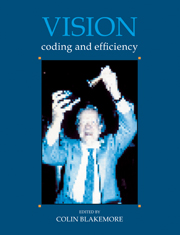Book contents
- Frontmatter
- Contents
- List of Contributors
- Preface
- Reply
- Acknowledgements
- Concepts of coding and efficiency
- Efficiency of the visual pathway
- Colour
- Brightness, adaptation and contrast
- Development of vision
- 19 On reformation of visual projection: cellular and molecular aspects
- 20 Retinal pathways and the developmental basis of binocular vision
- 21 Development of visual callosal connections
- 22 Sensitive periods in visual development: insights gained from studies of recovery of visual function in cats following early monocular deprivation or cortical lesions
- 23 The developmental course of cortical processing streams in the human infant
- 24 Maturation of mechanisms for efficient spatial vision
- 25 The puzzle of amblyopia
- Depth and texture
- Motion
- From image to object
- Index
24 - Maturation of mechanisms for efficient spatial vision
Published online by Cambridge University Press: 05 May 2010
- Frontmatter
- Contents
- List of Contributors
- Preface
- Reply
- Acknowledgements
- Concepts of coding and efficiency
- Efficiency of the visual pathway
- Colour
- Brightness, adaptation and contrast
- Development of vision
- 19 On reformation of visual projection: cellular and molecular aspects
- 20 Retinal pathways and the developmental basis of binocular vision
- 21 Development of visual callosal connections
- 22 Sensitive periods in visual development: insights gained from studies of recovery of visual function in cats following early monocular deprivation or cortical lesions
- 23 The developmental course of cortical processing streams in the human infant
- 24 Maturation of mechanisms for efficient spatial vision
- 25 The puzzle of amblyopia
- Depth and texture
- Motion
- From image to object
- Index
Summary
Introduction
One of the most remarkable achievements of the human visual system is the capacity to resolve fine detail in the retinal image and efficiently to detect contrast between neighbouring regions of the image. In the central visual field these perceptual abilities appear to be limited by the physical properties of the photoreceptors themselves. The development of spatial vision provides a fine example of the way in which the efficiency of coding in the visual system emerges through an interplay between innate (presumably genetically determined) organization and plasticity of synaptic organization at the level of the visual cortex. As Barlow (1972) pointed out, developmental plasticity might allow the visual cortex to discover, in the pattern of stimulation it receives, important associations and coincidences in the retinal image that relate to the nature of the visual world.
Efficiency of spatial vision in the adult
Factors that might limit spatial vision
The resolution of spatial detail and the detection of contrast in the retinal image might, in principle, be limited by one of a number of factors. Obviously, the optical quality of the image could determine spatial performance and certainly does so in states of refractive error. Even when the eye is accurately focused, chromatic and spherical aberration degrade the image, as does the effect of diffraction, which is dependent on the size of the pupil. Interestingly, under photopic conditions, the pupil of the human eye tends to adopt a diameter that optimizes visual acuity: a larger pupil size would augment the effects of aberrations and a smaller one would increase diffraction, as well as decreasing retinal illumination (Campbell & Gregory, 1960).
- Type
- Chapter
- Information
- VisionCoding and Efficiency, pp. 254 - 266Publisher: Cambridge University PressPrint publication year: 1991
- 34
- Cited by



